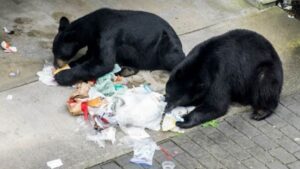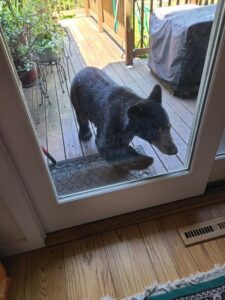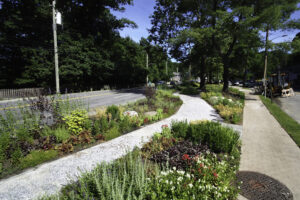
Black bears are heading south – as sightings in Tarrytown, Sleepy Hollow, Greenburgh and elsewhere confirm. With an expanding population now estimated at 6,000 to 8,000 in New York State, these impressive creatures are exploring more widely, especially the young males, looking to establish their own territories after they’ve been kicked out by their families.
The bears have zero interest in us, or our pets. All they want is a quiet life and a high-calorie diet, especially in the spring, after hibernation and the leaner months of winter. They’re poor hunters and don’t eat much meat. Instead, they rely mainly on vegetation and insects, with occasional carrion.
Early in the year, they’ll seek out skunk cabbage and dandelions. Later, the menu switches to berries, chokecherries and other fruits; and in the fall, it’s time for the bulky stuff – acorns, and beech nuts. Also, as fans of ants, larvae, bees and termites, they can often be tracked through signs of snacking, like flipped-over stones, or chewed rotting wood.
***
 But for a real calorie-boost, bears have learned — and they are smart, with impressive memories — that garbage cans, food scraps containers, and bird-feeders offer calorie-dense feasts. And given their claws, they’re able to open cans and feeders that other animals can’t. So, the simple way to avoid bears on your property is to secure your garbage and scraps containers, best in a locked shed or garage, or with a ratcheted strap or lock on the can itself. You should also make sure that your garage door openers are functioning properly for the safety and security of your family. It would also help if you use commercial trash removal services to ensure your garbage won’t linger in your yard for too long.
But for a real calorie-boost, bears have learned — and they are smart, with impressive memories — that garbage cans, food scraps containers, and bird-feeders offer calorie-dense feasts. And given their claws, they’re able to open cans and feeders that other animals can’t. So, the simple way to avoid bears on your property is to secure your garbage and scraps containers, best in a locked shed or garage, or with a ratcheted strap or lock on the can itself. You should also make sure that your garage door openers are functioning properly for the safety and security of your family. It would also help if you use commercial trash removal services to ensure your garbage won’t linger in your yard for too long.
Bird feeders should be taken down when bears are foraging most widely, from late March or early April, through to November. And if you keep bees, know that you are also offering a delicious meal to the bears, and that the best remedy is hire a fencing company to install an electric fence or get a fence rental around the hives.
***
Contact between a human and a black bear happens very rarely. These animals are conflict-averse and wary of people. (And people are probably wary of the bears, which can run, for short distances, at up to 35 miles per hour.) But if you do meet a black bear, or you see them hanging around your yard, the advice is to move slowly and back away if you feel the need to escape. Alternatively, make them feel uncomfortable by yelling, clapping, and making yourself look big, mean and scary. Don’t corner them, but chase them away with a bullhorn, if you have one handy, or by banging pots and pans.
Remember, it’s us, not the bears, who are the problem. So, try to avoid taking photos or feeding them. Instead, haze them, even invest in an animal-repelling device with built-in alarm and flashing lights. Encourage them to see your yard as a place of risk and no reward, and they’ll get the message.
Report a bear sighting here > wildlife.r3@dec.ny.gov
More information > dec.ny.gov/animals/6960.html
Briarcliff Manor resident Elsbeth Lindner is a regular contributor to River Journal North and River Journal. Photos submitted by River Journal readers.






